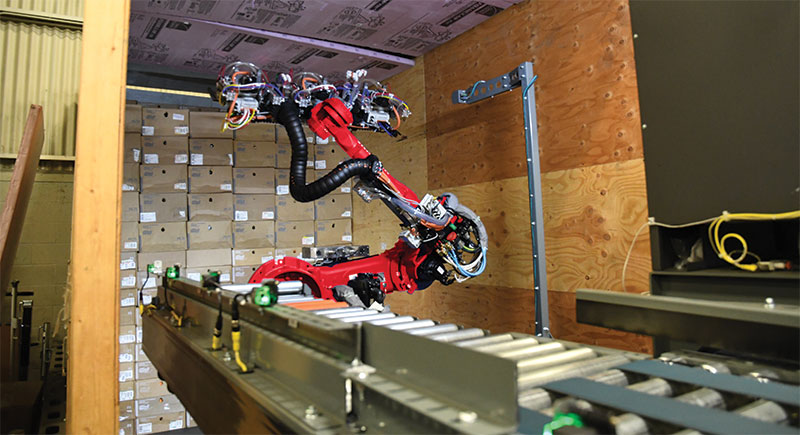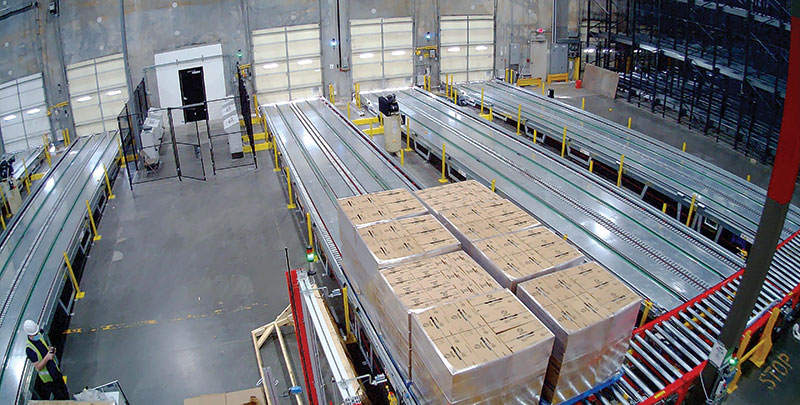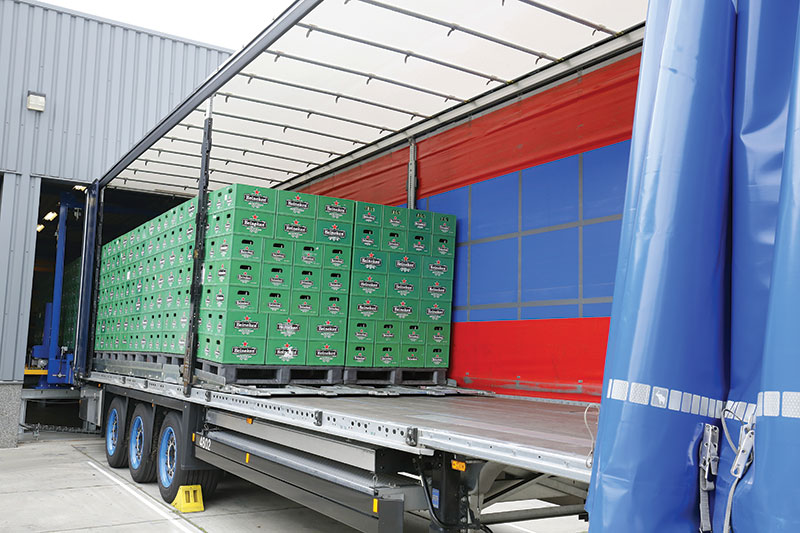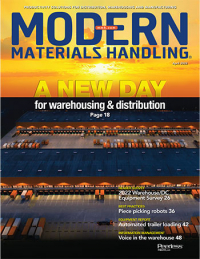Want big gains? Automate the ins and outs with automated trailer loading systems (ALTS)
Whether it’s trying to efficiently load or unload full pallets, or deal with the burdens of manual case loading and unloading, inbound and outbound docks are places where operations can make significant gains with automation, as well as safety and reducing product damage.
The pressures on shipping and receiving processes today are immense. Labor is scarce and difficult to retain. Order volumes are high. Supply shortages are forcing some companies to buy as much inventory when they can, causing further pressure on inbound workflows.
Those are the problems, but there is a bright side: The systems for automating unloading and loading processes are progressing rapidly, especially when it comes to the use of intelligent robotics. More established are various types of automated trailer loading systems (ATLS) that rapidly load a whole trailer full of pallets in a one-shot movement, or automatic guided vehicles (AGVs) tailored for loading and unloading processes.
The newer technologies that leverage artificial intelligence (AI) and articulating arms promise to do something new: automate the loading and unloading of highly variable cartons and cases into tidy, well-organized shipments that make good use of a trailer’s cubic space. In the past, that task was often left to the human workforce and its strong backs, perhaps with the help of telescoping, powered conveyor.
Think of loading and unloading solutions as varied and involving multiple technologies, rather than being necessarily about AI-driven robotics. The challenges are hefty, but the automation choices are growing, too.
Enter the robots
The robotic approach grabbed plenty of attention earlier this year when DHL Supply Chain, a major 3PL that is part of Deutsche Post DHL Group, announced with robotics vendor Boston Dynamics that it would roll out a mobile manipulation robot from Boston Dynamics called Stretch to automate item unloading tasks across multiple facilities to the tune of a $15 million investment.

The project involved close collaboration over the past few years as Stretch was being developed and tested. Boston Dynamics will deliver a fleet of Stretch robots to multiple DHL warehouses throughout North America over the next three years. The robot will tackle several box-moving tasks in the warehouse, beginning with truck unloading at select DHL facilities. Following the first deployment, the multi-purpose robot may handle additional tasks.
“At DHL Supply Chain, we are committed to continuous innovation and digital transformation to optimize the end-to-end supply chain,” Sally Miller, CIO of DHL Supply Chain North America, stated when the collaboration was announced. “Investing in warehouse automation plays an important role in increasing operational efficiency and improving service for our customers. The Stretch robot addresses complex industry challenges through flexible automation, which we’ll be able to replicate and scale regionally and globally.”
Stretch moves on a compact, omni-directional mobile base and features a lightweight arm as well as a gripper with advanced sensing and controls to handle a large variety of box types and sizes. Stretch is touted as being able to autonomously handle complex situations like disordered stacking configurations and recovering fallen boxes.
Stretch moves one box at a time and can handle boxes weighing up to 50 pounds at a rate of up to 800 cases per hour, depending on trailer and box configuration, according to Kevin Blankespoor, senior vice president of warehouse robotics at Boston Dynamics.
Industry and supply chain pressures, along with robotics advancements, make it a good time to consider robotics for tough tasks like unloading smaller items, Blankespoor says. “The pandemic has created massive supply chain issues all over the globe, disrupting and delaying the movement of goods in ports, warehouses and distribution centers,” he says. “Stretch can help logistics companies meet surging demand and keep a steady volume of goods moving through facilities.”
A benefit of automating the unloading of cartons with robotics, Blankespoor contends, is that operations can use the labor savings to reassign workers to other tasks. “We designed Stretch to automate the toughest part of these warehouse jobs, which keeps employees safer and frees them up to perform more strategic and valuable work,” Blenkespoor says. “We intentionally design our robots so they can be easily operated by almost anyone, without the need for a specialized degree. We envision today’s box movers being tomorrow’s robot operators, capable of managing fleets of robots in warehouses, plants and other industrial environments.”

Other vendors are involved in applying AI-based robotics to unloading and loading tasks. Honeywell Intelligrated has been working on robotic, AI-based solutions for trailer unloading for several years, having introduced a solution in 2019 called its general merchandise robotic unloader.
That system uses a wide section of powered conveyor and a wide row of end effectors to grasp and automatically unload packages in bulk fashion onto its conveyor. That earlier solution is no longer for commercial sale, but that technology led to Honeywell developing a different autonomous robotic solution for truck unloading and loading that uses an articulated arm for case handling, says Thomas Evans, chief technology officer for Honeywell Robotics.
Going forward, the articulated arm solution will use the AI and vision system research and development that Honeywell undertook when it introduced its Smart Flexible Depalletizer solution last year. Evans says the articulating robotic arm system can load and unload cases, and that Honeywell is already in the “execution” phase of applying the vision and AI technology that went into its Smart Flexible Depalletizer solution to the articulating arm solution for load and unload tasks. The solution will look similar to the depalletizer robot, though attached at the end of stretch of powered conveyor that extends into trailers.
The overall aim for Honeywell, Evans says, is to tap into AI and vision R&D for multiple solutions—first with the depalletizer robot and now with the updated articulating arm that automates the loading and unloading of cases. Both solutions, he says, use AI and vision technology building blocks to flexibly adapt to different case sizes and variability in the structure of loads.
“What I’m doing with the customers that have our loading and unloading articulated arm, I’m encouraging them to look at our Smart Flexible Depalletizer, and its vision capabilities and its intelligence in dealing with variability, and the advanced articulation capabilities of that arm,’” Evans says.

In practice, Evans explains, depalletizing and unloading and loading applications all call for a system adept at dealing with variability. With depalletizing, the AI and vision for the robot needs to know how to depalletize a single-SKU pallet load, and then a mixed-SKU pallet, in any sequence.
Similarly, a case loading and unloading robotic arm needs to know how to load a highly structured trailer, but the next one may be more loose loaded, or need a different pattern.
“Our vision system, and the AI and intelligence we’ve developed, is the key to be able to do that consistently from trailer to trailer, and provide the needed flexibility, at an acceptable rate for the customer to get a return on their investment,” says Evans.
A key benefit of using core AI and vision building blocks for warehouse robotics, says Evans, is to make solutions quicker to deploy, since 80% of the capabilities are extensively modeled and tested before a system gets installed.
“The process we’ve taken on is to build 80% under a generalized approach that is non-customer specific,” Evans says. “With this approach, when we get to the customer site, that deployment and commissioning phase should not need to extend much beyond what you have with more traditional materials handling solutions.”
Importantly, says Evans, the articulating arm loading and unloading solution has an end-effector design that can grasp and handle two or three cases at a time, rather than one, much like the smart depalletizer robot can grasp and manipulate multiple cases in one movement.
“The articulated arm is capable of picking three cases at a time and loading three cases at a time, or picking and unloading three cases at a time, which is where we get rates reaching up to 900 to 1,000 picks per hour, which allows a solution like this to really compete with the speed of a manual process,” says Evans.
ATLS efficiencies
Automated trailer loading systems (ATLS) based on digitally controlled mechanisms involving skates, rollers or slip chains have been proven for decades. They are efficient at safely loading pallets of goods onto trailers, making them popular with food and beverage companies and other consumer goods companies that ship high volumes of unitized goods. Some systems can also load and unload other items like tires or paper rolls.
ATLSs carry time and labor savings advantages versus manually loading trailers with lift trucks, while eliminating the chance of product or equipment damage within the actual loading task, since an ATLS, once its staging conveyor is fully loaded, can load a full trailer in two to three minutes, says Bill Witwer, director of sales for Loading Automation, which offers multiple types of ATLSs under a turnkey approach. “The operator of the system simply pushes a button, and the trailer is loaded in about two and half minutes,” says Witwer.
By contrast, loading a trailer with manually operated lift trucks can take 20 to 30 minutes, and with trucks going in and out of the tight confines of a trailer, there’s a chance for incidents and damage that aren’t possible when an ATLS automatically loads the trailers in a one-shot, mechanized movement. Some clients, Witwer adds, may further automate by using pallet conveyor or AGVs to bring loads to the ATLS staging conveyor.
Loading Automation’s customers include household names such as Anheuser-Busch, which uses their automated slip-chain and roller trailer system to regularly shuttle empty aluminum cans and glass bottles from nearby suppliers to breweries, and Harley-Davidson, which uses a powered chain and roller type ATLS for moving finished motorcycles from a production plant to a nearby warehouse.
For companies with regular “shuttle runs” like these, ATLSs speed up shipping and receiving processes, free up lift truck operators, and reduce the chance of product damage.
“That time savings is where much of the justification for these systems come from, though you also eliminate damage to loads and equipment, and increase turnaround times for the operation,” says Witwer. “You can achieve payback for an ATLS that is handling 30 trailer loads a shift, which is pretty typical for a lot of these high-volume applications we see, in less than two years.”
While the shuttle run scenario is a sweet spot for ATLS, they can also bring payback for longer hauls if the volume is high enough, adds Witwer. Safety also is concern for many operations. With Loading Automation’s systems, the ATLS is often integrated to dock controls and trailer restraint systems to ensure a high level of safety, Witwer adds.
Additionally, while many ATLS designs do call for a modified trailer and a fixed staging conveyor area dockside, some do not, says Witwer. There are variations, and a consulting and integration element to putting together the ideal solution for each operation.
“There isn’t any one solution I try to promote,” says Witwer. “It depends on each customer’s application needs, and what the environment is, in terms of space and material flow. And, although there are different ways to automate loading and unloading, the benefits are similar, involving time savings, eliminating the chance for damage, increased safety, and reducing the personnel requirement in loading and receiving, which has become such an important issue with the labor shortages operations are facing.”
The time savings from ATLSs, compared to loading with human-operated lift trucks, dramatically compresses loading and unloading cycle times, making it possible to move more goods with the same number of trucks, says Jack W. Smylie, North America sales manager for Ancra Systems, an ATLS solution provider. This is a major driver for ATLSs for shorter shuttle runs, which typically involve an ATLS with a modified trailer.
With ATLS, not only can the operation reassign lift truck operators and save time dock side versus using lift trucks, the truck drivers and their rigs have wait times of just a few minutes at the dock, versus 30 minutes or longer when using lift trucks to load or unload, says Smylie.
“With a modified trailer system, if you were using 10 trucks for a shuttle run operation before automating, you can cut that down to five trucks pretty easily,” Smylie says. “It really comes down to the number of loads you can turn per hour. If a driver is pulling up with a modified trailer for one of our ATLS solutions, the cycle time is very short, because the trailer loads in three minutes instead of 30 minutes or more depending on how you were loading the truck previously. Now you are turning the trucks much faster at each end. That’s a major decision driver for an ATLS with a modified trailer.”
Ancra’s customers with ATLS solutions include Lineage Logistics (at a former Preferred Freezer Services operation), DB Schenker and Procter & Gamble. While ATLSs that call for modified trailers match up well with shorter shuttle runs with a higher degree of control over load profiles and trailers, some ATLSs do not require a modified trailer, adds Smylie, which opens up automated loading efficiencies to more operations. For example, Ancra offers an ATLS called Skateloader, developed to automatically load standard, non-modified trailers.
The Skateloader can work with either palletized or slip-sheeted goods for outbound transport, and it can work with non-modified trailers. Ancra estimates that this non-modified trailer ATLS can cut the overall loading cycle from 30 or 40 minutes with lift trucks to around 8 minutes, which allows a single dock door to handle three to four trailers per hour.
“There are different ATLS approaches to handle different needs,” says Smylie. “With a non-modified system like our Skateloader, whatever standard trailer pulls up can be loaded, which opens up the benefits of ATLS to operations that need to ship one way to multiple sites or customers.”
It’s fairly common, Smylie adds, for users of ATLS solutions to also use pallet conveyors or AGVs to fully automate the outbound process from palletizing and wrapping, all the way out to the ATLS and right into the trailers. “Pallet conveyor combined with ATLS brings a high level of speed and efficiency to the whole outbound process,” says Smylie.
Purpose built AGVs
AGVs are another path to automating loading of trailers with pallets, and in some cases, unloading. Vendors stress that AGVs for these tasks may call for some special ruggedness and navigation features.
Dematic, which is part of KION Group, for example, offers an automatic trailer loading (ATL) and trailer unloading (UTUL) system built to handle regular driving over rough and uneven dock plates. A combination of laser and natural target navigation allows the AGVs to see into the trailer without modifications to trailers, docks or facilities. These AGVs can support various required loading patterns, including mixed-orientation and pinwheel patterns.
“One of the primary changes for an ATL AGV compared to standard AGVs is the increase in the clear height,” explains Brian Spradlin, vice president of mobile automation at the KION Group. “This increased clearance is needed to accommodate variations in deck height and dock ramps. The chassis and drive wheel configurations are also modified for robust and reliable performance in these applications. Other modifications to ATL AGVs are focused on mitigating differences in trailer walls and flooring.”
Using AGVs for loading and unloading is growing given operational pressures such as labor shortages, says Mark Longacre, applications engineering manager for AGV at JBT Corp. “JBT entered the automated trailer loading market very early: more than 10 years ago,” he says. “This market has grown slowly over the years and is now accelerating quickly, similar to many automation applications and markets. The driving factors nearly always involve reassigning labor to more value-added processes and minimizing product and facility damage while improving safety in the dock area.”
JBT’s ATL is in its third generation. The ATL AGVs offer larger, softer tires, tilting masts and dual rear drives for ease of travel over dock plates and inside trucks. Two forms of navigation are used: natural feature navigation, which is dynamic and adaptable, and “wall following” navigation that uses raw data from SICK sensors to sense the trailer walls to ensure it’s in the center of the trailer. Trailer loading algorithms detect the trailer’s center and adjust the load directly on board the vehicle with as little as a one-inch clearance on all sides.
Longacre explains that JBT’s first ATL applications tended to be shorter, regular loads moving from a manufacturing plant to a nearby DC, and while these continue to be good applications, ATL AGVs are now seeing broader appeal.
“We are now automating some distribution facilities with more pallet variations and trucks going much farther away,” Longacre says. “In the beginning we typically loaded fairly heavy products, where trailer capacity was weight limited. Now we can load light product where the tailer volume is cubed out. We’ve even loaded unpalletized, slip sheet loads.”
Acute challenges in finding enough labor, specifically skilled lift truck operators, is driving stronger interest in ATL AGVs, though reduced product damage and worker safety remain important.
“We’ve had customers say they could justify automation from just dock door accidents and damage reduction alone,” Longacre says. “Now more customers are commenting that they’re moving past just traditional ROI and payback justifications. These customers are very concerned with the lack of qualified candidates to run manual fork lifts to load and unload trailers. They say it’s well beyond trying to reduce costs, and that their very survival will be based on automating these operations.”

Article Topics
ATLS News & Resources
Want big gains? Automate the ins and outs with automated trailer loading systems (ALTS) Heico Companies acquires Ancra Systems automatic truck loading and unloading systemsLatest in Materials Handling
ASME Foundation wins grant for technical workforce development The (Not So) Secret Weapons: How Key Cabinets and Asset Management Lockers Are Changing Supply Chain Operations MODEX C-Suite Interview with Harold Vanasse: The perfect blend of automation and sustainability Consultant and industry leader John M. Hill passes on at age 86 Registration open for Pack Expo International 2024 Walmart chooses Swisslog AS/RS and software for third milk processing facility NetLogistik partners with Vuzix subsidiary Moviynt to offer mobility solutions for warehouses More Materials HandlingAbout the Author
Subscribe to Materials Handling Magazine

Find out what the world's most innovative companies are doing to improve productivity in their plants and distribution centers.
Start your FREE subscription today.
April 2024 Modern Materials Handling

Latest Resources












